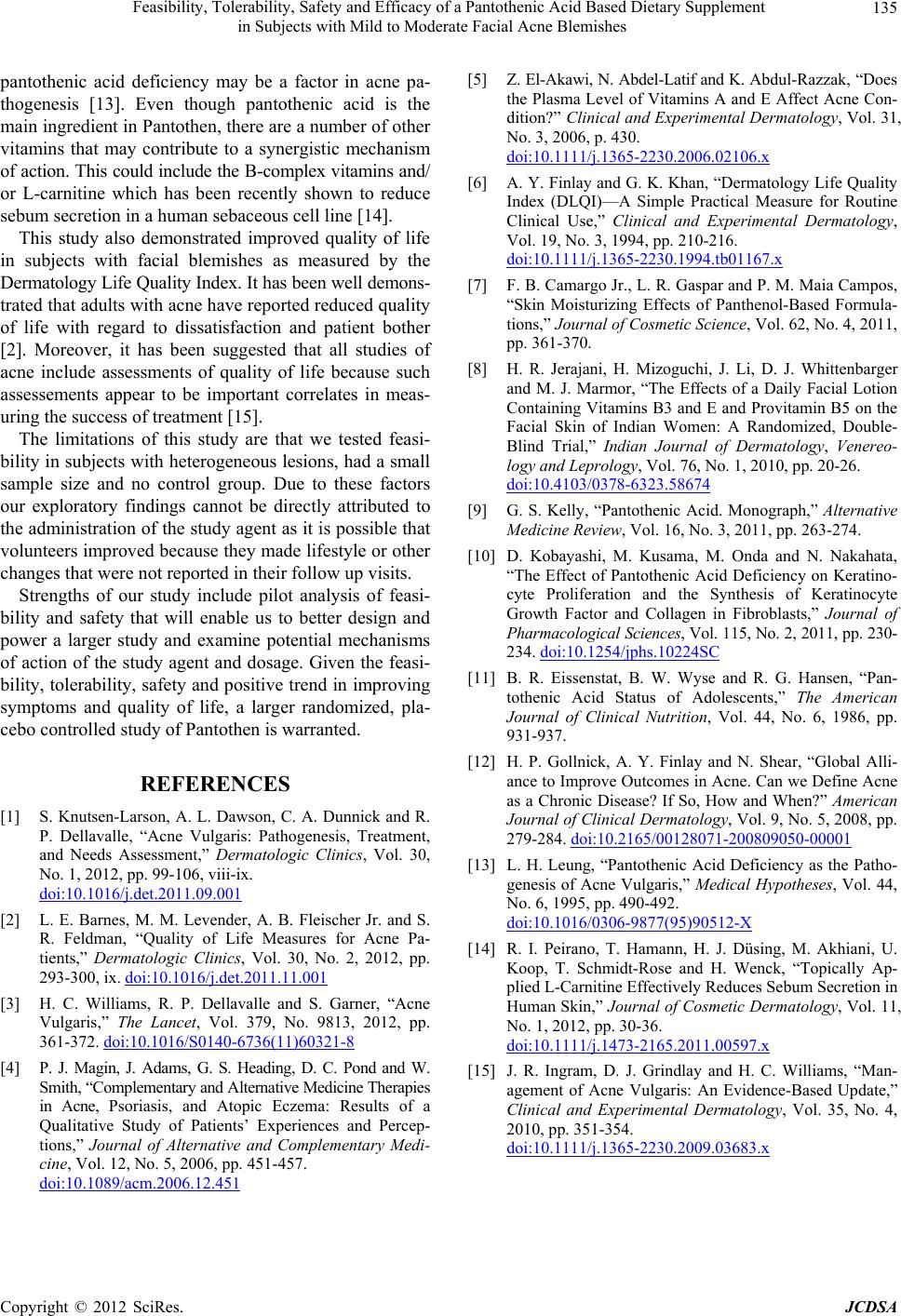
Feasibility, Tolerability, Safety and Efficacy of a Pantothenic Acid Based Dietary Supplement
in Subjects with Mild to Moderate Facial Acne Blemishes
Copyright © 2012 SciRes. JCDSA
135
pantothenic acid deficiency may be a factor in acne pa-
thogenesis [13]. Even though pantothenic acid is the
main ingredient in Pantothen, there are a number of other
vitamins that may contribute to a synergistic mechanism
of action. This could include the B-complex vitamins and/
or L-carnitine which has been recently shown to reduce
sebum secretion in a human sebaceous cell line [14].
This study also demonstrated improved quality of life
in subjects with facial blemishes as measured by the
Dermatology Life Quality Index. It has been well demons-
trated that adults with acne have reported reduced quality
of life with regard to dissatisfaction and patient bother
[2]. Moreover, it has been suggested that all studies of
acne include assessments of quality of life because such
assessements appear to be important correlates in meas-
uring the success of treatment [15].
The limitations of this study are that we tested feasi-
bility in subjects with heterogeneous lesions, had a small
sample size and no control group. Due to these factors
our exploratory findings cannot be directly attributed to
the administration of the study agent as it is possible that
volunteers improved because they made lifestyle or other
changes that were not reported in their follow up visits.
Strengths of our study include pilot analysis of feasi-
bility and safety that will enable us to better design and
power a larger study and examine potential mechanisms
of action of the study agent and dosage. Given the feasi-
bility, tolerability, safety and positive trend in improving
symptoms and quality of life, a larger randomized, pla-
cebo controlled study of Pantothen is warranted.
REFERENCES
[1] S. Knutsen-Larson, A. L. Dawson, C. A. Dunnick and R.
P. Dellavalle, “Acne Vulgaris: Pathogenesis, Treatment,
and Needs Assessment,” Dermatologic Clinics, Vol. 30,
No. 1, 2012, pp. 99-106, viii-ix.
doi:10.1016/j.det.2011.09.001
[2] L. E. Barnes, M. M. Levender, A. B. Fleischer Jr. and S.
R. Feldman, “Quality of Life Measures for Acne Pa-
tients,” Dermatologic Clinics, Vol. 30, No. 2, 2012, pp.
293-300, ix. doi:10.1016/j.det.2011.11.001
[3] H. C. Williams, R. P. Dellavalle and S. Garner, “Acne
Vulgaris,” The Lancet, Vol. 379, No. 9813, 2012, pp.
361-372. doi:10.1016/S0140-6736(11)60321-8
[4] P. J. Magin, J. Adams, G. S. Heading, D. C. Pond and W.
Smith, “Complementary and Alternative Medicine Therapies
in Acne, Psoriasis, and Atopic Eczema: Results of a
Qualitative Study of Patients’ Experiences and Percep-
tions,” Journal of Alternative and Complementary Medi-
cine, Vol. 12, No. 5, 2006, pp. 451-457.
doi:10.1089/acm.2006.12.451
[5] Z. El-Akawi, N. Abdel-Latif and K. Abdul-Razzak, “Does
the Plasma Level of Vitamins A and E Affect Acne Con-
dition?” Clinical and Experimental Dermatology, Vol. 31,
No. 3, 2006, p. 430.
doi:10.1111/j.1365-2230.2006.02106.x
[6] A. Y. Finlay and G. K. Khan, “Dermatology Life Quality
Index (DLQI)—A Simple Practical Measure for Routine
Clinical Use,” Clinical and Experimental Dermatology,
Vol. 19, No. 3, 1994, pp. 210-216.
doi:10.1111/j.1365-2230.1994.tb01167.x
[7] F. B. Camargo Jr., L. R. Gaspar and P. M. Maia Campos,
“Skin Moisturizing Effects of Panthenol-Based Formula-
tions,” Journal of Cosmetic Science, Vol. 62, No. 4, 2011,
pp. 361-370.
[8] H. R. Jerajani, H. Mizoguchi, J. Li, D. J. Whittenbarger
and M. J. Marmor, “The Effects of a Daily Facial Lotion
Containing Vitamins B3 and E and Provitamin B5 on the
Facial Skin of Indian Women: A Randomized, Double-
Blind Trial,” Indian Journal of Dermatology, Venereo-
logy and Leprology, Vol. 76, No. 1, 2010, pp. 20-26.
doi:10.4103/0378-6323.58674
[9] G. S. Kelly, “Pantothenic Acid. Monograph,” Alternative
Medicine Review, Vol. 16, No. 3, 2011, pp. 263-274.
[10] D. Kobayashi, M. Kusama, M. Onda and N. Nakahata,
“The Effect of Pantothenic Acid Deficiency on Keratino-
cyte Proliferation and the Synthesis of Keratinocyte
Growth Factor and Collagen in Fibroblasts,” Journal of
Pharmacological Sciences, Vol. 115, No. 2, 2011, pp. 230-
234. doi:10.1254/jphs.10224SC
[11] B. R. Eissenstat, B. W. Wyse and R. G. Hansen, “Pan-
tothenic Acid Status of Adolescents,” The American
Journal of Clinical Nutrition, Vol. 44, No. 6, 1986, pp.
931-937.
[12] H. P. Gollnick, A. Y. Finlay and N. Shear, “Global Alli-
ance to Improve Outcomes in Acne. Can we Define Acne
as a Chronic Disease? If So, How and When?” American
Journal of Clinical Dermatology, Vol. 9, No. 5, 2008, pp.
279-284. doi:10.2165/00128071-200809050-00001
[13] L. H. Leung, “Pantothenic Acid Deficiency as the Patho-
genesis of Acne Vulgaris,” Medical Hypotheses, Vol. 44,
No. 6, 1995, pp. 490-492.
doi:10.1016/0306-9877(95)90512-X
[14] R. I. Peirano, T. Hamann, H. J. Düsing, M. Akhiani, U.
Koop, T. Schmidt-Rose and H. Wenck, “Topically Ap-
plied L-Carnitine Effectively Reduces Sebum Secretion in
Human Skin,” Journal of Cosmetic Dermatology, Vol. 11,
No. 1, 2012, pp. 30-36.
doi:10.1111/j.1473-2165.2011.00597.x
[15] J. R. Ingram, D. J. Grindlay and H. C. Williams, “Man-
agement of Acne Vulgaris: An Evidence-Based Update,”
Clinical and Experimental Dermatology, Vol. 35, No. 4,
2010, pp. 351-354.
doi:10.1111/j.1365-2230.2009.03683.x